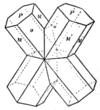1911 Encyclopædia Britannica/Staurolite
STAUROLITE, a mineral consisting of basic aluminium and ferrous iron silicate with the formula HFeAl5Si2O13. The material is, however, usually very impure, the crystals enclosing sometimes as much as 30 or 40% of quartz and other minerals as well as carbonaceous matter. Crystals are orthorhombic and have the form of six-sided prisms. Interpenetrating cruciform twinned crystals are very common and characteristic; they were early known as pierres de croix or lapis crucifer, and the name staurolite, given by J. C. Delametherie in 1792, has the same meaning (Greek, aravpos, a cross, and X10os, a stone). In fig. 1 the twin-plane is (032) and the two prisms intercross
 |
 |
| Fig. 1. | Fig. 2. |
| Twinned Crystals of Staurolite. | |
at an angle of 91 22'; in fig. 2 the twin-plane is (232) and the prisms intercross at nearly 6o°. The mineral is translucent to opaque and dark reddish-brown in colour; it thus has a certain resemblance to garnet, and on this account has been called grenatite. Waterworn pebbles of material sufficiently transparent for cutting as gem-stones are occasionally found in the diamantiferous sands of Brazil. The hardness is 71/2 and the specific gravity 3·75. Staurolite is a characteristic mineral of crystalline schists, and it is also a product of contact-metamorphism. Large twinned crystals with rough surfaces a.re found in mica-schist in Brittany and at several places in the United States, e.g. in Fannin county, Georgia. Untwinned crystals, translucent and of a rich brown colour (grenatite), are abundant in the silvery white paragonite-schist of Monte Campione, St Gothard. (L. J. S.)
